 Kia Forte: Cylinder Head Installation
Kia Forte: Cylinder Head Installation
| ŌĆó
|
Thoroughly clean all parts to be assembled.
|
| ŌĆó
|
Always use new cylinder head and manifold gaskets.
|
| ŌĆó
|
Always use new cylinder head bolts. Cylinder head bolts
are toque-to-yield bolts designed to be permanently elongated
beyond the state of elasticity when torqued, so if the bolts
are removed and reused, it may cause the bolts to break or fail
to maintain clamping force.
|
| ŌĆó
|
The cylinder head gasket is a metal gasket. Take care
not to bend it.
|
| ŌĆó
|
Rotate the crankshaft to set the No.1 piston at TDC (Top
dead center) on compression stroke.
|
|
|
1. |
Install the cylinder head gasket (B) on the cylinder block.
|
(1) |
Remove hardening sealant, oil, dust, moisture and harmful
foreign materials from the cylinder block and the cylinder head.
|
|
(2) |
Apply liquid gasket on the edge of the cylinder block.
|
|
(3) |
Install the cylinder head gasket with the dowel pins of
the cylinder block.
|
|
(4) |
Apply liquid gasket on the edge of the cylinder head gasket.
|
Apply liquid gasket on the edge of the cylinder
block and cylinder head gasket.
|
Sealant:
Threebond 1217H or equivalent
|
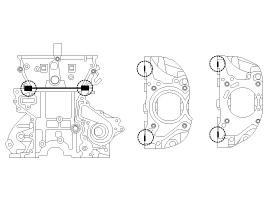
|
Assemble the cylinder head gasket and the cylinder
head within 5 minutes after applying sealant.
|
|
|
|
2. |
Place the cylinder head (A) carefully to protect damage to the
head gasket during installation.
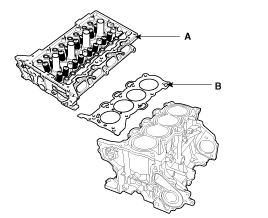
|
|
3. |
Install the cylinder head bolts with washers.
Using SST (09221-4A000), install and tighten the 10 cylinder head
bolts, in several passes, in the sequence as shown.
Tightening torque
1st step:
32.4 ~ 36.3 N.m (3.3 ~ 3.7 kgf.m, 23.9 ~ 26.8 lb-ft)
2nd step: 90~95┬░
3rd step: 90~95┬░
|
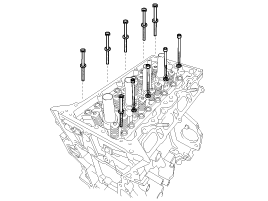
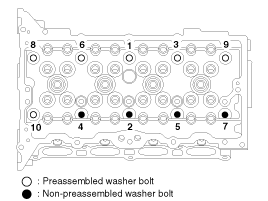
|
ŌĆó |
Always use new cylinder head bolts. Cylinder head
bolts are toque-to-yield bolts designed to be permanently
elongated beyond the state of elasticity when torqued,
so if the bolts are removed and reused, it may cause
the bolts to break or fail to maintain clamping force.
|
|
ŌĆó |
Do not apply engine oil on the bolt threads to
achieve correct torque.
|
|
ŌĆó |
Remove the extruded sealant within 5 minutes after
installing cylinder head bolts.
|
|
ŌĆó |
The engine running or pressure test should not
be performed within 30 minutes after installing cylinder
head bolts.
|
|
ŌĆó |
Be careful not to change the installing position
of the preassembled washer bolts and non-preassembled
washer bolts.
|
|
ŌĆó |
When installing the washer of the non-preassembled
washer bolts, the round and chamfer of washers should
be faced up.
|
|
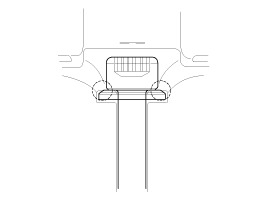
|
|
4. |
Install the rear engine hanger (A).
Tightening torque:
34.3 ~ 39.2N.m (3.5 ~ 4.0kgf.m, 25.3 ~ 28.9lb-ft)
|
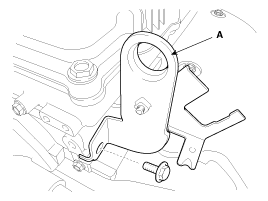
|
|
5. |
Install the exhaust oil control valve (OCV) (A).
Tightening torque:
9.8 ~ 11.8 N.m (1.0 ~ 1.2 kgf.m, 7.2 ~ 8.7 lb-ft)
|

|
|
6. |
Install the intake oil control valve (OCV) (A).
Tightening torque:
9.8 ~ 11.8 N.m (1.0 ~ 1.2 kgf.m, 7.2 ~ 8.7 lb-ft)
|
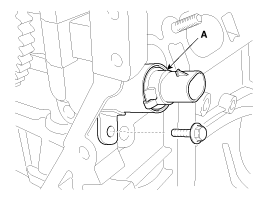
|
ŌĆó |
Do not reuse the OCV when dropped.
|
|
ŌĆó |
Keep the OCV filter clean.
|
|
ŌĆó |
Do not hold the OCV sleeve (A) during servicing.
|
|
ŌĆó |
When the OCV is installed on the engine, do not
move the engine with holding the OCV yoke.
|
|
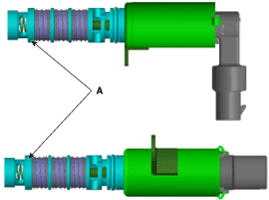
|
|
7. |
Install the oil control adapter (A) with a new gasket (B).
Tightening torque:
9.8 ~ 11.8 N.m (1.0 ~ 1.2 kgf.m, 7.2 ~ 8.7 lb-ft)
|
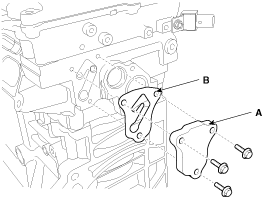
|
|
8. |
Install the water temperature control assembly.
(Refer to Cooling System - ŌĆ£Water Temperature Control AssemblyŌĆØ)
|
|
9. |
Install the hydraulic lash adjuster (HLA)(A) and the swing arm
(B).
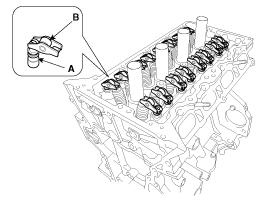
|
(1) |
When installing HLA, it should be held upright so that
engine oil in HLA may not spill and assured that dust does not
adhere to HLA.
|
|
(2) |
HLA should be inserted carefully to the cylinder head
not to spill engine oil.
If installing with engine oil spilling out of the lash
adjuster and air in it, it might make an abnormal noise.
|
If engine oil has spilled out of the lash adjuster, HLA bleeding
should be performed according to the below procedure.
HLA bleeding procedure
Stroke the lash adjuster in engine oil by pushing its cap 4 to
5 times while pushing the ball down slightly using a hard steel wire.
Be careful not to give the ball a hard push because the ball weighs
just several grams.
If installing with engine oil spilling out of the lash adjuster
and air in it, it might make an abnormal noise.
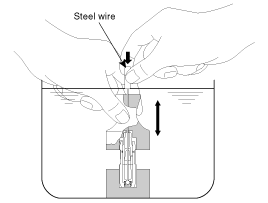
|
|
10. |
Install the cam carrier.
|
(1) |
Using a gasket scraper, remove all the old packing material
from the gasket surfaces.
|
|
(2) |
The sealant locations on the cam carrier and the cylinder
head must be free of harmful foreign materials, oil, dust and
moisture. Spray cleaner on the surface and wipe with a clean
duster.
|
|
(3) |
After applying liquid sealant on the bottom surface of
the cam carrier, assemble the cam carrier. Continuous bead of
sealant should be applied to prevent any path from oil leakage.
Bead width:
2.5 ~ 3.5 mm (0.10 ~ 0.14 in.)
Sealant:
Threebond 1217H or equivalent
|
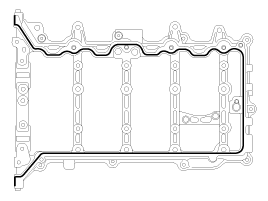
|
|
(4) |
Place the cam carrier (A) on the cylinder head. The dowel
pins on the cam carrier and holes on the cylinder head should
be used as a reference in order to assemble the cam carrier
in exact position.
|
|
(5) |
Fasten the cam carrier bolts.
Tightening torque:
18.6 ~ 22.6 N.m (1.9 ~ 2.3 kgf.m, 13.7 ~ 16.6
lb-ft)
|
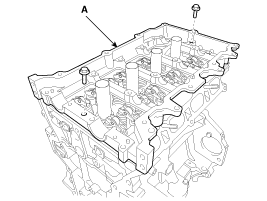
|
ŌĆó |
Assemble the cam carrier within 5 minutes
after applying sealant.
|
|
ŌĆó |
Assemble the camshaft bearing cap within
5 minutes after assembling the cam carrier.
|
|
ŌĆó |
The engine running or pressure test should
not be performed within 30 minutes after assembling
the cam carrier.
|
|
|
|
|
11. |
Install the camshafts.
|
(1) |
Place the intake and exhaust camshafts (A) on the cam
carrier.
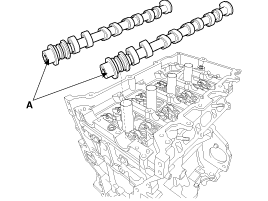
|
|
(2) |
Install the camshaft bearing cap (A).
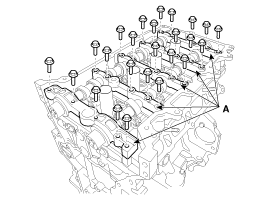
Tighten the bolts, in several passes, in the sequence
as shown.
Tightening torque
M6 bolts:
11.8 ~ 13.7 N.m (1.2 ~ 1.4 kgf.m, 8.7 ~ 10.1 lb-ft)
M8 bolts:
18.6 ~ 22.6 N.m (1.9 ~ 2.3 kgf.m, 13.7 ~ 16.6
lb-ft)
|
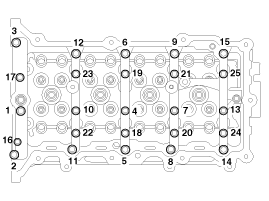
|
Be careful not to change the position and direction
of bearing caps.
|
|
|
|
12. |
Install the intake CVVT assembly (A) and exhaust CVVT assembly
(B).
Tightening torque:
64.7 ~ 76.5 N.m (6.6 ~ 7.8 kgf.m, 47.7 ~ 56.4 lb-ft)
|
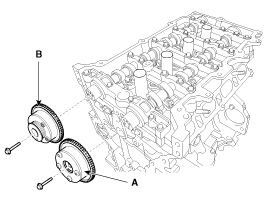
|
When removing the CVVT assembly bolt, hold the camshaft
with a wrench to prevent the camshaft from rotating.
|
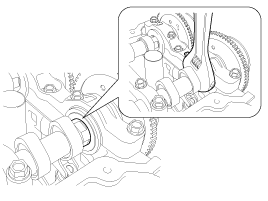
|
|
13. |
Install the PCSV bracket (A).
Tightening torque:
9.8 ~ 11.8 N.m (1.0 ~ 1.2 kgf.m, 7.2 ~ 8.7 lb-ft)
|
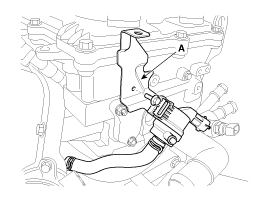
|
|
14. |
Install the condenser (A).
Tightening torque:
9.8 ~ 11.8 N.m (1.0 ~ 1.2 kgf.m, 7.2 ~ 8.7 lb-ft)
|
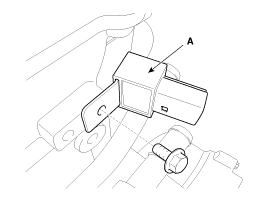
|
|
15. |
Install the vacuum pipe (A).
Tightening torque:
9.8 ~ 11.8 N.m (1.0 ~ 1.2 kgf.m, 7.2 ~ 8.7 lb-ft)
|
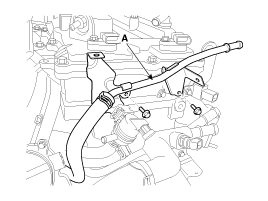
|
|
16. |
Install the other parts reverse order of removal.
|
|
17. |
Add all the necessary fluids and check for leaks. Connect GDS.
Check for codes, note, and clear. Recheck.
|
| ŌĆó
|
Refill engine with engine oil.
|
| ŌĆó
|
Refill a radiator and a reservoir tank with engine coolant.
|
| ŌĆó
|
Clean battery posts and cable terminals and assemble.
|
| ŌĆó
|
Inspect for fuel leakage.
|
| -
|
After assembling the fuel line, turn on the ignition switch
(do not operate the starter) so that the fuel pump runs for
approximately two seconds and fuel line pressurizes.
|
| -
|
Repeat this operation two or three times, then check for
fuel leakage at any point in the fuel line.
|
| ŌĆó
|
Bleed air from the cooling system.
|
| -
|
Start engine and let it run until it warms up (until the
radiator fan operates 3 or 4 times).
|
| -
|
Turn off the engine. Check the level in the radiator,
add coolant if needed. This will allow trapped air to be removed
from the cooling system.
|
| -
|
Put radiator cap on tightly, then run the engine again
and check for leaks.
|
|
ŌĆó
Thoroughly clean all parts to be assembled.
ŌĆó
...
See also:
Removal
1.
Engine cover.
(Refer to Engine Mechanical System - "Engine cover")
2.
Air cleaner assembly and air duct.
(Refe ...
Fuel Tank Pressure Sensor (FTPS) Removal
1.
Turn the ignition switch OFF and disconnect the battery negative
(-) cable.
2.
Remove the rear seat.
(Refer to Body - ŌĆ£Rear Se ...
Brake Pedal
Components
1. Cowl bracket
2. Brake pedal member assembly
3. Stop lamp switch
4. Return spring
5. Brake pedal
6. Bolt
...
 Kia Forte: Cylinder Head Installation
Kia Forte: Cylinder Head Installation Cylinder Head Reassembly
Cylinder Head Reassembly Cylinder Block
Cylinder Block























